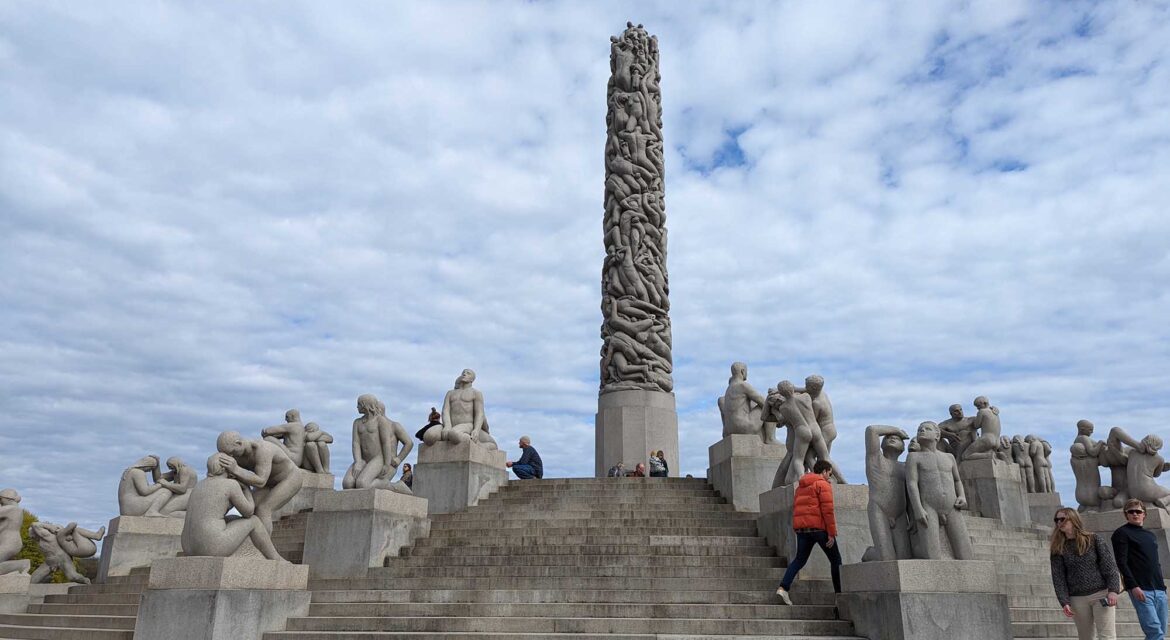 The largest sculpture park by a single artist in the world, Vigeland Sculpture Park has become the most notable monument in Oslo, Norway. Featuring over 200 sculptures in granite, bronze and wrought iron, Vigeland Sculpture Park creates experiences on every level for audiences by enabling them to connect with themes that transcend eras and cultures.
The largest sculpture park by a single artist in the world, Vigeland Sculpture Park has become the most notable monument in Oslo, Norway. Featuring over 200 sculptures in granite, bronze and wrought iron, Vigeland Sculpture Park creates experiences on every level for audiences by enabling them to connect with themes that transcend eras and cultures.

The Fountain, the Monolith and the Bridge
 Gustav Vigeland is one of the most famous artists in Norway. He came up with the idea of an outdoor park for his sculptures in 1914, although the process to install all of the sculptures and features in Fronger Park would take place over the next 40 years and well after his death in 1943. Also called the Vigeland installation, the 212 sculptures have become synonymous with Fronger Park, which is the largest park in the center of Oslo.
Gustav Vigeland is one of the most famous artists in Norway. He came up with the idea of an outdoor park for his sculptures in 1914, although the process to install all of the sculptures and features in Fronger Park would take place over the next 40 years and well after his death in 1943. Also called the Vigeland installation, the 212 sculptures have become synonymous with Fronger Park, which is the largest park in the center of Oslo.
The first major piece to be installed was the Fountain in 1924. Surrounded by 20 statues in all stages of life from childhood to death, the Fountain represents the cycle of human life and all its emotions. The center of the basin six giants hold the large saucer-shaped vessel above their head, with the other sculptures and reliefs representing life’s evolving stages, stretching from childhood and adolescence through adulthood to old age and death. This theme is explored and showcased in countless ways across the landmark.
The most notable of all the sculptures is the Monolith, which stands at the highest point in Vigeland Sculpture Park. Installed in 1944. the Monolith, was carved from carving from a single piece of Iddefjord granite. Depicting 121 intertwined human figures, each figure represents a different stage of life, with children at the top and the oldest figures at the bottom. It has been interpreted as a kind of vision of resurrection while also being connected to people’s inherent longing and striving for spirituality. Set around the “circle of life” series of 46 granite sculptures, these pieces depict men, women and children working through interconnected challenges and triumphs of their various stages of life.
The Bridge has 58 bronze sculptures showing people of all different ages. Opened in 1940, these figures were designed to showcase the human body in different forms, some of which have become iconic in their own right. Representing themes related to play, lust, energy and vitalism, these features and sculptures compel interest and engagement that can be seen across the park and the entire city of Olso.

The Top Attraction in Oslo
 Sinnataggen (The Angry Boy) is just one of the many sculptures in the park but it has become one of the most iconic. Nearby is a sculpture of a man looking like he’s being attacked by babies, which has also achieved iconic status. Their placement on merchandise is just one of the many direct economic benefits that the Vigeland Sculpture Park has enabled.
Sinnataggen (The Angry Boy) is just one of the many sculptures in the park but it has become one of the most iconic. Nearby is a sculpture of a man looking like he’s being attacked by babies, which has also achieved iconic status. Their placement on merchandise is just one of the many direct economic benefits that the Vigeland Sculpture Park has enabled.
A richly illustrated book called “Vigeland and the Park,” allows readers to experience the sculpture park through all seasons. Sold in the museum shop, it is available in English and Norwegian.
Mentioned as one of the top “must-see places” in Norway, the free-to-enter Vigeland Sculpture Park is an attraction that appeals to residents and visitors for very different reasons. The transformation of the space and creation of the most significant monument in Oslo is fueled by themes that connect with essential human experiences to create countless benefits in the present that are set to be further developed in the future. 
Representing a Legacy of Humanity
 Regularly attracting over a million visitors, Vigeland Sculpture Park has connected with audiences on account of the incredibly significant sculptures that define it. However, the legacy of humanity that it represents is what ultimately compels both residents and visitors to continually engage with the space. This sort of representation can be achieved at any scale, across endless locations, highlighting the endless possibilities that a monument can cultivate across the eras.
Regularly attracting over a million visitors, Vigeland Sculpture Park has connected with audiences on account of the incredibly significant sculptures that define it. However, the legacy of humanity that it represents is what ultimately compels both residents and visitors to continually engage with the space. This sort of representation can be achieved at any scale, across endless locations, highlighting the endless possibilities that a monument can cultivate across the eras.

